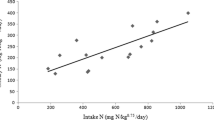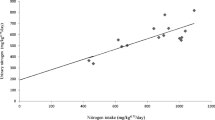Abstract
The use of fruit-based diets by a small arboreal marsupial, the woolly opossum (Caluromys philander) was studied to elucidate the mechanisms used to compensate for a low dietary protein concentration. The passage of a liquid phase digesta marker (Cr-EDTA) through the gut was significantly faster when animals were fed a diet containing 0.45% N compared to that measured on a diet containing 0.90% N. The size of the gut of the two groups was similar except that the caecum of animals fed 0.45% N was significantly larger than in those animals fed 0.90% N. Animals fed a diet of 0.45% N ate significantly more food than those fed higher levels of nitrogen but there was no significant difference in the dry matter digestibility of the diet. The maintenance nitrogen requirement of the animals was 176 mg dietary N or 146 mg truly digestible nitrogen per kg metabolic body mass, with low losses of non-dietary faecal nitrogen being notable. There was no significant difference between diets in any measured parameter of urea metabolism and all animals recycled between 60% and 80% of the endogenously synthesised urea.
Similar content being viewed by others
Author information
Authors and Affiliations
Additional information
Accepted: 22 March 2000
Rights and permissions
About this article
Cite this article
Foley, W., Charles-Dominique, P. & Julien-Laferriere, D. Nitrogen requirements of the didelphid marsupial Caluromys philander . J Comp Physiol B 170, 345–350 (2000). https://doi.org/10.1007/s003600000109
Issue Date:
DOI: https://doi.org/10.1007/s003600000109




